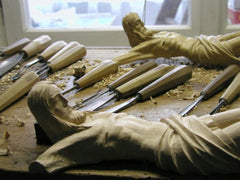About Us and the Crucifixes We Sell
Hand Carving Traditions
A Brief Background of Our Crucifixes
Our hand-carved crucifixes come from a geographical area where this special skill has had a long tradition. The first wooden crucifixes appeared approximately around 1700 A.D. Since then, the craft of wood carving was passed down from generation to generation. It withstood the First and Second World Wars. In 1948, when the communists took power in Slovakia, they actively persecuted Christians. Thankfully, the tradition survived the forty years of persecution. Because of the love and devotion of ordinary people, the tradition of masterfully hand carving crucifixes lives on today. What you will find here on this website is the testimony of these people to carry on this skill and art to this day.
Making Wooden Devotional Articles The Traditional Way


Our Artisans
Our artisans individually hand-carve all of their works of art using methods that have been passed down the generations. We pride ourselves in using these craftsmen to produce our devotional articles rather than having them cheaply manufactured in bulk in other countries. While we would greatly reduce our production costs if we did, it is just not our priority. We want to be able to provide our customers the best. We also want to support the people who, for generations, have dedicated their lives to keeping this art alive and strong.
Types of Woods Used
Softer woods like linden wood are typically used for the corpus to make it easier to carve. Harder woods like oak wood are used for making crosses as it gives the crucifix structural hardness. The block of wood used for carvings are at least one inch larger than the final piece.
Overview of How Carvings Are Done
The master carver makes sure all his tools are razor sharp such that the tools should leave a shiny cut through the wood. If there is a nick in the blade, it will leave a white streak. The carver secure the block of wood on the table so that both hands are free to control the tools. For safety and control, he keeps both hands on the tools behind the sharp edge at all times.
The carving is accomplished by cutting in a downward direction onto the parallel lines of the grain. The direction of the grain is determined by looking at the darker streaks of the annual rings, that indicate the long cell fibers that run from the roots of the tree to the leaf canopy.
Large U-shaped gouges help to remove the maximum amount of material. Large shapes are established first - they're defined by major planes of the corpus. As soon as the basic shapes are rounded, the details are added with small gouges.
The Final Result?
A beautifully hand-carved limited production crucifix!


